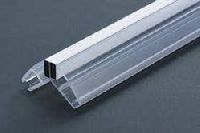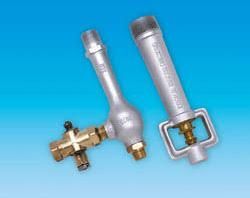
Magnetic Seal
A Magnetic seal comprises of a sealed chamber (Shroud), which contains a rotating Inner Shaft, which is embedded with powerful Inner Magnets. This inner shaft is supported on Upper and Lower Bearings. These are special Bearings, capable of withstanding harsh environments present inside the Reactor. A special barrier filter prevents dust from entering the Bearing Area. The output shaft of MotorGearbox assembly is locked on to an Outer Rotor, which is fitted with an Outer Magnet Assembly. When the Motor is switched on, the Outer Rotor Rotates, and magnetic flux causes the inner shaft to rotate synchronously with the Outer Rotor. Top Entry Magnetic Seals are the safest method for sealing agitated Reactors. Their applications include High Pressure Autoclaves such as Hydrogenators, as well as Reactors used for handling sensitive or hazardous products.
...more
Gas Induction Reactors
FEATURES Hydrogenation Oxidation Ozonisation Carboxylation Amination Aminolysis Ethoxylation Similar Gas - Slurry Reactions REACTION ENGINEERING In the Process Industry, many chemical reactions are carried out between liquids / slurries and gases, Traditionally, such gas-slurry reactions have been carried out with the help of equipment, where basically, an agitator was used to stir the liquid in the Reactor. This somewhat clumsy method resulted in less than satisfactory performance, due to non-ideal mixing, which led to poor catalyst suspension, negligible gas-liquid interfacial areas, as well as low heat and mass transfer coefficients. An Omega Kemix Gas - Induction Reactor offers a radial change from this conventional approach. Instead of churning the liquid reaction mass, a hollow agitator pumps gases from the head space to the lowest part of the Reactor vessel, as shown in the picture. A specially designed impeller vigorously disperes these gases into the reactor bottom, resulting in a mixture akin to a boiling liquid. Gas bubbles react with liquid/slurry as the as they rise. Unreacted gases are re-inducted into the liquid. The self-aspiration agitator of an Omega Gas-Induction Reactor has a highly efficient design, which leads to the following advantages: Vigorous Gas Liquid mixing Thorough suspension of solid components (e.g Catalyst) Large gas-liquid interfacial areas (Typical, interfacial area is 100 to 300 m2 pm3 of operating volume) Enhanced Gas-Liquid and Liquid Mass Transfer rates Very high vessel side heat transfer coefficients, which approach boling coefficients Reduced Bath times Minimal side reactions Excellent Bath-to-Bath Repeatability APPLICATIONS Catalytic hydrogenation Gas-liquid reaction with suspended Solids Gas-slurry reactions Ozonisation/Oxidation Amination/Aminolysis
...more
CATALYST FILTER SYSTEM
CATALYST FILTERS FOR HYDROGENATORS AND AUTOCLAVES Catalyst filtration is an important aspect of a Hydrogenation system. Omega- Kemix supplies a cost effective system, which incorporates. Complete filtration Operational safety Full backwash Minimal holdup of the reaction mass The filter is Fitted with sintered candles Has a special Heel filter Provided with a sight flow indicator Provided with special valves for effective dislodgement of catalyst cake Omega-Kemix make filter has the following advantages Safe procedure for catalyst filtration from the Autoclave There is no spillage of expensive catalyst Closed circuit operation avoids fire hazards in case of pyophoric catalysts High efficiency candles result in very low losses, which are often below measurable limits The filtration system pays for itself through high rate of catalyst recovery CATALYST FILTERS FOR HYDROGENATORS AND AUTOCLAVES: Catalyst filtration is an important aspect of a Hydrogenation system. Omega ‐ Kemix supplies a cost effective system, which incorporates complete filtration, operational safety, full backwash, as well as minimal holdup of the reaction mass. OPERATING PRINCIPLE AND PROCEDURE: At the completion of hydrogenation reaction, balance Hydrogen gas in reactor headspace is vented, and the Reactor is purged with Nitrogen, to eliminate all traces of remaining Hydrogen. Subsequently, the Reactor is pressurized to about 1 bar with Nitrogen, through Valve V1 Valves V2, V3 and V4 are opened. All othe valves (V5 to V8) are in closed position. Nitrogen is continuously fed through Valve V1, so that Reactor pressure is maintained around 1 bar. Typically, if the catalyst is noble metal on a carrier, e.g., Pd/C, the entire mass is filtered. In this case, it is advisable to stir the reaction mass at around 50 RPM, and the dip pipe or blow leg should extend to the lowest possible point in the Reactor. For heavy metal catalysts like Raney Nickel, the bulk of the catalyst settles within a very short time, typically 30 minutes after cessation of stirring. In this case, a common practice is to filter the supernatant liquid (through a dip pipe terminating just below the lower tan line of the Reactor). Nitrogen pressure in the Reactor headspace forces the liquid‐catalyst slurry into the Main Filter through Valve V₃. This filter is fitted with sintered SS 316 L candles, suspended from a tubesheet. These candles also have a 0.2 micron thick vapor deposited Stainless Steel membrane, of the desired micron size, typically 1 to 3 μ. Initially, the Filter body fills up with Liquid‐catalyst slurry. When it is full, filtration commences. Catalyst cake accumulates outside the candles. Clear filtrate enters the candles, and flows out through Valve V4. Filtrate flow can be observed through Sight Flow Indicator (FI). Once the Reactor contents are entirely displaced by Nitrogen, gas will flow into the Filter through V3. The Filter Candles are fitted with an inner Siphon Tube. Gas entering the Filter displaces the slurry, so that clear liquid is siphoned out through Valve V4, due to action of siphon tubes in the candles. Due to this action, slurr level in the Filter falls to the lower end of the candles. In effect, the filter cone and lower parts are full of unfiltered slurry (also known as "Heel"), and candles are coated with wet cake. At this point, only gas flows through the Sight Flow Indicator. A Zero Holdup Filter is fitted at the lower end of the Main Filter, below the conical portion. This is a Jacketed Sintered pipe (or Lower Candle), around 125 mm inside diameter, suitable for inside to outside filtration. The sintered pipe has a similar 0.2 micron thick vapor deposited Stainless Steel membrane on the inside, to facilitate surface filtration. Please refer Drawing 2 for details of the Zero Holdup Filter. When gas flow (i.e., no liquid flow) is observed through the Sight Flow indicator as described above, Valve V4is closed, and V₉ is opened. Nitrogen gas entering the Filter cone forces filtrate through the Lower Candle, so that slurry in the Filter Cone and lower parts is filtered through the Zero Holdup Filter. Heel filtrate is observed flowing through the Sight Flow Indicator FI. Once the entire heel slurry is filtered, no further liquid flow is observed through the Sight Flow Indicator. All the slurry has been filtered. At this stage, outer surfaces of the upper candles, and inner surface of the lower candle are covered with wet cake. Valves V9, V3 and V2 and V1 are now closed, and the Reacto vented to atmospheric pressure, by opening Valve V10. Solvent/feed for the next batch, or Nitrogen at 1 to 5 bar is introduced at Valve V5, located at the top of the Filter. Keeping Valve V10 open, Valve V8 and then Valve V6 is opened, so that catalyst adhering to candle surfaces gets back‐flushed into the Reactor. For best results, Valve V6 should be a Solenoid operated ball valve, so that there is a pressure pulse while opening this valve. This ensures effective dislodgement of catalyst cake from the Candles. This procedure ensures a safe procedure for catalyst filtration from the Autoclave. There is no spillage of expensive catalyst. The closed circuit operation avoids fire hazards, as many catalysts are pyrophoric, and can spontaneously ignite when exposed to air. High efficiency candles result in very low losses, which are often below measurable limits. The filtration system pays for itself. After several batch cycles, it may be necessary to remove catalyst from the system, and send it for disposal or regeneration. In this case, Valve V7 is opened instead of V8, during back flushing operation, and spent catalyst collected in the Recycle Drum.
...more
Air Gas Mixer
OMEGA Static Mixer can be designed to suit every mixing application. In most cases, more than 1 model can achieve the desired mixing OMEGA Static Mixers are available in 3 standard types, each of which delivers specific Process results. In each type, several models are available in different sizes and materials of construction. Our Technical Personnel can advise you on the optimum choice, taking into account fluid properties, degree of mixing desired power requirements, and space limitations.
...moreBe first to Rate
Rate ThisOpening Hours